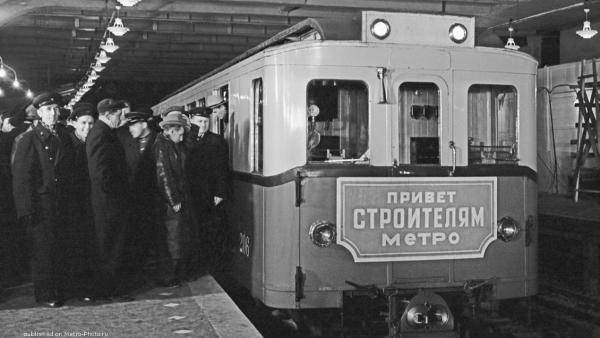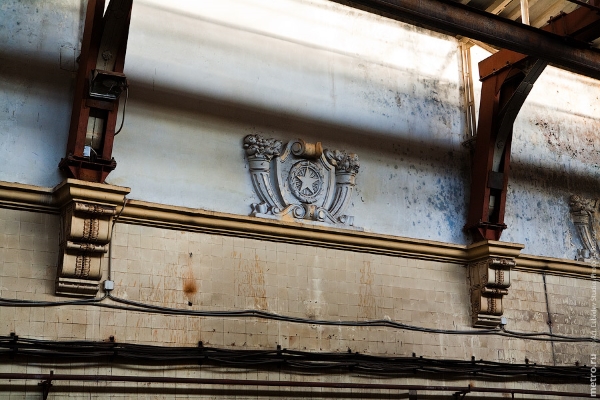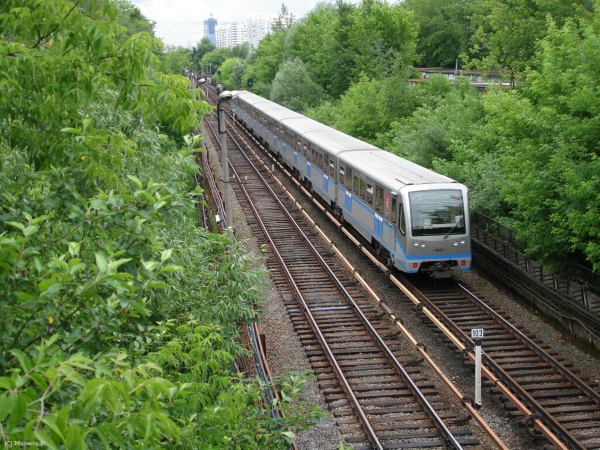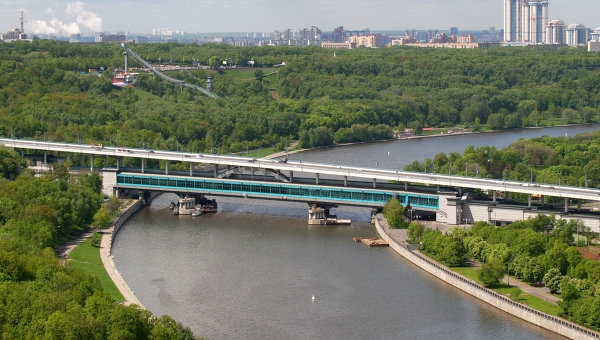Sixty years ago the first overland section of the Moscow metro was inaugurated – from Izmailovskaya station to Pervomaiskaya station. Georgy Osipov recounts story of other overland sections of the Moscow metro and how they changed the cityscape.
Verticals of bygone times

A train bursts out of the tunnel like a squirrel from a trunk hollow into the pure air, opening up one of the best views for the Moscow subway – the huge Church Pokrovsky in Izmailovo, a red-brick tower with a clock resembling a chime. Until the mid 1960s that architectural landscape had been complemented by the tallest in Moscow parachute tower that belonged to the then Central Stalin Leisure and Recreation Park. Originally named in its honor, the station changed quite a few names during its 50-year history (Izmailovsky Park, Izmailovskaya and now Partizanskaya). It was to be named in honor of a different object which in prewar times was designed at the site of the present-day hotel complex – the world’s largest (and how could it be otherwise in the 1930s?) sports arena – hence the huge platform to the amazement of many, and three entryways…
But over the operating track the train rushes out of the tunnel immediately to the right, leaving on the left access ways and edifices of Izmailovsky Car Garage. Admittedly, few are eager to look into its rear. Nothing seems special in those yards and garages – a typical seamy side of life of the big city. But do not be too hasty… The building crowned with a clock tower hardly fits into the surrounding development and it’s hard to imagine that an entire boulevard once led to it, or rather to the Pervomaiskaya subway stop situated in that building, to be more exact – the facade inscription “Moscow Metro named after L.M. Kaganovich, Station Pervomaiskaya” disappeared just a short time ago.
Some stations of the Moscow Metro, originally designed as temporary, waiting for this or that radial track to be laid, actually vanished from the face of the earth – this is what happened to the old Kaluzhskaya station (not to be confused the Oktyabrskaya of the Ring Line, once so named) – after 1974 as the metro line was extended to Belyaevo and further. On the other hand, former Pervomaiskaya was never planned as temporary. It’s no coincidence that it is similar to the roofed train sheds of some railroad terminals, such as Kiev Station, as is so clearly seen in an old photograph. True, that railway terminal covered by imposing metal structures designed by architect Shukhov while Pervomaiskaya is the only case in the history of the Moscow Metro where they were content with a wooden roof.

That station lasted less than seven years. One day shy of a year after its opening there came roaring a rather famous resolution of the Council of Ministers “On elimination of excesses in design and construction” and adverse winds began blowing over Soviet architecture (metro stations no exception). One of the yard shops was set up on the former terminal station and the central platform was dismantled along with its marble slabs. It was replaced by quite another Pervomaiskaya without any hallmarks of an overland lobby – the first one of those stations which sharp-tongued Muscovites dubbed as “centipedes”.
Today few will be lucky enough to visit the metro train shed – not the best place for tours, and the “cancelled” station is not mentioned in travel guides. Even in the images showing today’s everyday life of the metro workers the remnants of erstwhile splendor can be clearly discerned: the eaves above the rail tracks, a characteristically Soviet stucco molding with gilt all worn off, stars and turgid sheaves of wheat…
Filevsky sprouts
The old Pervomaiskaya was closed for passengers on October 21, 1961. And a week before that, October 13, its seed “sprouted” as the next section from Kutuzovskaya to Pionerskaya stations of Filevskaya Line was opened. Beyond any doubt, this is the most unusual line in the Moscow metro.
The spirit of contradiction haunted this metro line at its very birth.The section from today’s Aleksandrovsky Sad station (then Ulitsa Kominterna) to Kievskaya was a shallow branch-out from the first line of the Moscow metro opened on May 15, 1935, before heavy weapons came into use. During Luftwaffe’s bombings part of the tunnel between Arbatskaya and Smolenskaya was damaged, and in 1951-1953 a duplicating deep-level length was built.
Since then confidence was entrenched in people’s minds that metro is not just a means of transport, but primarily a bomb shelter. This was further reinforced after information about the so-called second metro made its way into press and then into the blogosphere. Let it be so. But at the same time, in 1959-1961 an open metro section was built – the one leading to the prestigious western districts of Moscow. This is certainly no bomb shelter?

Rumors not infrequently linked the new image of Moscow metro stations with the head of state – a sensitive and susceptive personality. After Nikita Khrushchev saw an “aquarium” for party fora in Beijing, soon a similar palace of congresses emerged in Moscow. After feasting his eyes on skyscrapers in Havana, he took care of Moscow acquiring similar forms along Kalininsky Avenue, while open-air metro stations perhaps originated with what Khrushchev saw in Paris and New York. On the other hand, this link is hardly too straightforward – the same section from Izmailovsky Park to Pervomaiskaya stations had been designed and built long before the foreign tours of the head of state.
Yet the times of plenty were soon replaced by the era of asceticism. Can you remember the miserable furniture – tables and chairs on thin legs that filled standard small-size flats in standard five-storey blocks of flats? This so-called furniture often replaced the true masterpieces of furniture design that were sold via antique furniture salons at best or just dumped at worst.
And the image of the new metro stations set the tone. The new Filevskaya line dubbed by common people as the “blue line” still takes a noteworthy place in a peculiar “Guinness Records Book” of the Moscow underground. Judge for yourself: longest in the Moscow metro open lengths is one thing; shortest distances between platforms are the second thing; shortest platforms were the third factor. Finally, the sharpest curves, the only line with arched stations and so far the only line with a fork-like branch-out (to the Delovoi Tsentr station)!
And metro drivers like this line too. First there are fewer passengers here compared to other lines; secondly, most of the journey runs in the open air, rather than in the underground tunnel. Only one problem: the designers took little note of the Moscow climatic specifics: the concrete frameworks of the open stations were not designed for a long operation. One of the first bells rang after the end of the Olympics-80, when the metro bridge in Luzhniki was closed for 30-year-long repair, or rather new construction. This mammoth concrete structure was to be commissioned towards the next anniversary of the Great October, while eventually, according to experts, the true miracle was that the bridge did not crumble under the next train…
The open section was to become part of the line leading from Shchelkovskaya to the new quarters of Mitino. But as the Russian saying goes, “they did the tally and started crying.” The old rail tracks just could not stand to new loads, since somewhere along Filevskaya line you can see even today a genuine rarity – wooden rail ties. Therefore the open section had to be cut short at Kuntsevskaya station. Incidentally, rumors have to that the two subsequent stations – Molodezhnaya and Krylatskoe – are part of the “second metro” now opened for general access.
To close or not to close…

Today the experience of building open subway sections is relied upon, albeit with great caution and only using the latest materials available – such as on the Butovo light rail line or on the new section from Myakinino station to Volokolamskaya station, or in the construction of new open stations like Technopark.
As for the blue line – a holistic architectural ensemble dating from the time of Khrushchev’s Constructivism – has been threatened recently. The previous Moscow administration was brooding over the plan of spanning the entire line with a massive concrete box and building office-business centers over it, but those plans were halted by the economic crisis and Muscovites sounded an alarm on time. A short time ago the plan of lifting the Filevskaya line over the intersecting roads, just as in Paris. The logic is apparent: the land is too expensive to be utilized just for public transport.
Who could have known in 1954 how things would turn out?
Georgy Osipov

 A train bursts out of the tunnel like a squirrel from a trunk hollow into the pure air, opening up one of the best views for the Moscow subway – the huge Church Pokrovsky in Izmailovo, a red-brick tower with a clock resembling a chime. Until the mid 1960s that architectural landscape had been complemented by the tallest in Moscow parachute tower that belonged to the then Central Stalin Leisure and Recreation Park. Originally named in its honor, the station changed quite a few names during its 50-year history (Izmailovsky Park, Izmailovskaya and now Partizanskaya). It was to be named in honor of a different object which in prewar times was designed at the site of the present-day hotel complex – the world’s largest (and how could it be otherwise in the 1930s?) sports arena – hence the huge platform to the amazement of many, and three entryways…
A train bursts out of the tunnel like a squirrel from a trunk hollow into the pure air, opening up one of the best views for the Moscow subway – the huge Church Pokrovsky in Izmailovo, a red-brick tower with a clock resembling a chime. Until the mid 1960s that architectural landscape had been complemented by the tallest in Moscow parachute tower that belonged to the then Central Stalin Leisure and Recreation Park. Originally named in its honor, the station changed quite a few names during its 50-year history (Izmailovsky Park, Izmailovskaya and now Partizanskaya). It was to be named in honor of a different object which in prewar times was designed at the site of the present-day hotel complex – the world’s largest (and how could it be otherwise in the 1930s?) sports arena – hence the huge platform to the amazement of many, and three entryways… That station lasted less than seven years. One day shy of a year after its opening there came roaring a rather famous resolution of the Council of Ministers “On elimination of excesses in design and construction” and adverse winds began blowing over Soviet architecture (metro stations no exception). One of the yard shops was set up on the former terminal station and the central platform was dismantled along with its marble slabs. It was replaced by quite another Pervomaiskaya without any hallmarks of an overland lobby – the first one of those stations which sharp-tongued Muscovites dubbed as “centipedes”.
That station lasted less than seven years. One day shy of a year after its opening there came roaring a rather famous resolution of the Council of Ministers “On elimination of excesses in design and construction” and adverse winds began blowing over Soviet architecture (metro stations no exception). One of the yard shops was set up on the former terminal station and the central platform was dismantled along with its marble slabs. It was replaced by quite another Pervomaiskaya without any hallmarks of an overland lobby – the first one of those stations which sharp-tongued Muscovites dubbed as “centipedes”.  Rumors not infrequently linked the new image of Moscow metro stations with the head of state – a sensitive and susceptive personality. After Nikita Khrushchev saw an “aquarium” for party fora in Beijing, soon a similar palace of congresses emerged in Moscow. After feasting his eyes on skyscrapers in Havana, he took care of Moscow acquiring similar forms along Kalininsky Avenue, while open-air metro stations perhaps originated with what Khrushchev saw in Paris and New York. On the other hand, this link is hardly too straightforward – the same section from Izmailovsky Park to Pervomaiskaya stations had been designed and built long before the foreign tours of the head of state.
Rumors not infrequently linked the new image of Moscow metro stations with the head of state – a sensitive and susceptive personality. After Nikita Khrushchev saw an “aquarium” for party fora in Beijing, soon a similar palace of congresses emerged in Moscow. After feasting his eyes on skyscrapers in Havana, he took care of Moscow acquiring similar forms along Kalininsky Avenue, while open-air metro stations perhaps originated with what Khrushchev saw in Paris and New York. On the other hand, this link is hardly too straightforward – the same section from Izmailovsky Park to Pervomaiskaya stations had been designed and built long before the foreign tours of the head of state. Today the experience of building open subway sections is relied upon, albeit with great caution and only using the latest materials available – such as on the Butovo light rail line or on the new section from Myakinino station to Volokolamskaya station, or in the construction of new open stations like Technopark.
Today the experience of building open subway sections is relied upon, albeit with great caution and only using the latest materials available – such as on the Butovo light rail line or on the new section from Myakinino station to Volokolamskaya station, or in the construction of new open stations like Technopark.





